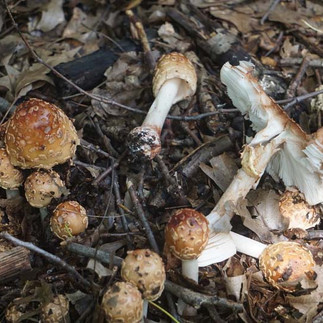Blushing Amanita - Amanita amerirubescens
- Aubrey
- Sep 12, 2021
- 3 min read
Good evening friends,
I've spent a portion of today traveling back from a lovely family wedding but now I'm excited to sit down together and dive into another stimulating installment of Mushroom Monday. This week's mushroom is Amanita amerirubescens, commonly known as the blushing amanita. Amanita amerirubescens actually comprises a complex of seven or more genetically distinct mushrooms that all share a similar morphology (physical appearance/structure). They have been popping up all over the park this summer but the featured specimens were pointed out to me by Sandra, an avid park birder/naturalist/friend of fungi, just south of the bird feeders on 7/11/2021.
Ecology
A. amerirubescens are mycorrhizal (form relationships with tree/plant roots to share nutrients) with oak trees and occasionally conifers (colloquially known as "evergreens" - your spruces, pines, firs, etc.). This complex is found in eastern North America and is closely related to Amanita rubescens of Europe. A. amerirubescens grow summer through fall in eastern North America and even into the winter in the more southerly latitudes. Like other mushrooms in the Amanita genus, A. amerirubescens grow with two veils. A veil is a thin membrane that can protect the mushroom while it grows into maturity. A. amerirubescens have both a universal veil that encapsulates the whole body of the mushroom, and a partial veil which attaches to the stipe (stem) and the outer margins of the cap. The partial veil protects the gills (spore-producing organs) from getting damaged before maturity. Remnants of the universal veil are the warty, brown flecks seen on the top of the cap. The skirt-like ring, or annulus, seen on the stipe is left over from the partial veil that protected the gills. Both features are on display in the first photo. The specimens photographed grow quite clustered together but I've noticed other instances in the park where these mushrooms grow as isolated individuals. It wouldn't be a surprise if we have a few different species in the park.
Fun Facts
These mushrooms earn their common name because they "blush" or bruise red when touched or injured. The term used to describe this discoloration is "rubescent". Next time you're with your friends looking at mushrooms that bruise reddish brown you can say "ah, notice the rubescence" and impress everyone with your mycological vocabulary. In the second photo you can see some of this rubescing in both the bulb of the unearthed mushroom and the gills of the broken mushroom. The rubescing (I quite enjoy the term) is also a key identifying factor that separates these mushrooms from their poisonous cousins. A. amerirubescens are technically edible when cooked - the European species contains a protein that ruptures red blood cells when consumed raw - but they share resemblance to some of the more ominous poisonous mushrooms you can encounter. From Alan Bergo's firsthand account it doesn't seem like these mushrooms are all that flavorful - and for many the risk is not worth the reward - but his meticulous process and methodology are worth the read for those that are interested in foraging mushrooms and specifically Amanitas.(1)
Here's to a night cap,
Aubrey
PS. My friend Zach sent me a titillating video on how mushroom time-lapses are filmed with the director of Fantastic Fungi, Louie Schwartzburg, who gets pleasantly philosophical at the end: https://www.youtube.com/watch?v=5yq0_mqN97s&ab_channel=WIRED
PPS. My coworker Erickson sent me a video of a light-hearted, yet incredibly educational, tour of Alan Rockefeller's lab. He's one of the sharpest mycological minds and the host, Joey Santore, helps make a lot of complex concepts quite accessible: https://www.youtube.com/watch?v=kJVXAALRfRo&ab_channel=CrimePaysButBotanyDoesn%27t
In-text References:
Additional References:
1) Kuo, M. (2016, July). Amanita rubescens. Retrieved from the MushroomExpert.Com Web site: http://www.mushroomexpert.com/amanita_rubescens.html
4) Kuo, M. (2013, June). The genus Amanita. Retrieved from the MushroomExpert.Com Web site: http://www.mushroomexpert.com/amanita.html






